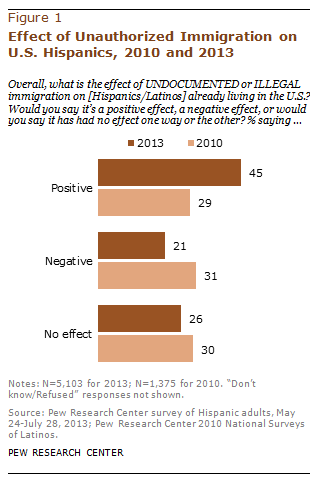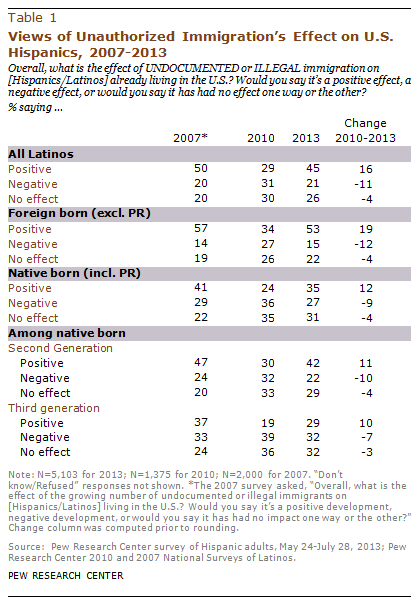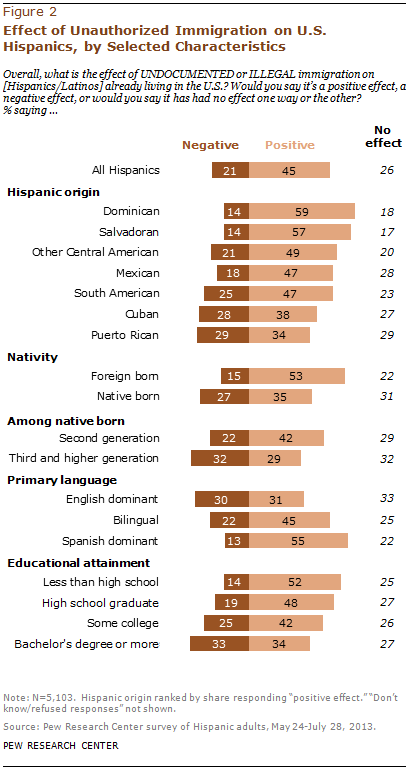Report

Hispanics’ views of the impact of unauthorized immigration on the U.S. Hispanic community have grown more positive since 2010, according to a new nationwide survey of 5,103 Hispanic adults by the Pew Research Center.
Today, 45% of Hispanic adults say the impact of unauthorized immigration on Hispanics already living in the U.S. is positive, up 16 percentage points from 2010 when 29% said the same.
Views of unauthorized immigration’s impact have improved more among foreign-born Hispanics than native-born Hispanics. According to the new survey, half (53%) of Hispanic immigrants say the impact of unauthorized immigration on the U.S. Hispanic community is positive, up 19 percentage points from 2010 when 34% said the same. This compares with a 12 percentage point increase in the share of native-born Hispanics who say the same—from 24% in 2010 to 35% in 2013.
Among the native born, views of unauthorized immigration’s impact on U.S. Hispanics differ by immigrant generation. Some 42% of second generation Hispanics (the native-born adult children of immigrant parents) say the impact of unauthorized immigration is positive.
By comparison, just 29% of third generation Hispanics (native-born adults of native-born parents) say the same. For both groups, the share saying the impact of unauthorized immigration is positive has grown since 2010—up 11 percentage points among second generation Hispanics and up 10 percentage points among third generation Hispanics.

Nonetheless, not all native-born Latinos say the impact of unauthorized immigration on U.S. Latinos is positive. Among third generation Latinos, one-third (32%) say the impact of unauthorized immigration on Latinos living in the U.S. is negative, and 32% say there is no effect one way or the other. For second generation Latinos, 22% say the impact of unauthorized immigration is negative and 29% say there is no effect.
Hispanics’ views of the impact of unauthorized immigration on U.S. Hispanics have nearly returned to those of 2007. Then, when asked a slightly different question,1 half (50%) of Hispanic adults said the growing number of unauthorized immigrants overall had a positive effect on the Hispanic community, 20% said it had a negative effect and 20% said there was no effect (Pew Hispanic Center, 2007).
Today, just as in 2010 and in 2007, the nation is in the midst of a contentious discussion about comprehensive immigration reform. However, it is possible that in 2010, a combination of a weak economy and a hardening political environment around immigration may have led to a more downbeat assessment of illegal immigration’s impact on U.S. Latinos. In 2010, the nation was emerging from the Great Recession and Arizona had passed its SB 1070 law that authorized local police to check the immigration status of anyone they suspected of being in the U.S. illegally.
The nation’s unauthorized immigrant population reached its peak of 12.2 million in 2007, but then declined to a recent low of 11.3 million in 2009. Preliminary evidence suggests it may be on the rise, standing at 11.7 million in 2012 (Passel, Cohn and Gonzalez-Barrera, 2013).
Overall, about three-quarters of all unauthorized immigrants are of Hispanic or Latin American origin (Passel and Cohn, 2010) and 52% of all unauthorized immigrants are from Mexico.
The Pew Research Center survey was conducted by landline and cellular telephone, in English and Spanish, from May 24 through July 28, 2013 among a nationally-representative sample of 5,103 Hispanic adults. The margin of error for the survey was plus or minus 2.1 percentage points. For details on the survey methodology, see Appendix A.
Views of Unauthorized Immigration’s Impact by Hispanic Demographic Sub-Group
Views of unauthorized immigration’s impact on the U.S. Hispanic community vary across demographic sub-groups of Hispanics.
For some groups of Hispanics, views of the effect of unauthorized immigration on U.S. Hispanics are positive. Dominicans (59%) and Salvadorans (57%) are the most likely to say unauthorized immigration’s effect on U.S. Hispanics is positive. In addition, half (49%) of other Central Americans, 47% of Mexicans and 47% of South American Hispanics say the same.
By comparison, assessments are less positive among Cubans and Puerto Ricans. Among Cubans, 38% say the impact of unauthorized immigration is positive, but 28% say the impact is negative and 27% say there is no impact one way or the other. Among Puerto Ricans, roughly equal shares say the impact of unauthorized immigration on U.S. Hispanics is positive (34%), negative (29%) or has no effect (29%).

Spanish-dominant Hispanics are positive about the impact of unauthorized immigrants on the Hispanic community with 55% saying their impact is positive. By contrast, opinions are split among English-dominant Hispanics—31% see a positive effect of unauthorized immigration, 30% see a negative effect and 33% say there is no impact one way or the other.
Educational attainment is also linked to views of unauthorized immigration’s effect on Latinos already living in the U.S. Half (52%) of Latinos who have less than a high school diploma and half (48%) of Latinos who are high school graduates say the impact of unauthorized immigration on U.S. Latinos is positive. By contrast, among Latinos with a bachelor’s degree, views are not as positive. Just one-third (34%) say the effect of unauthorized immigration is positive, 33% say it is negative and 27% say there has been no effect.2
References
Blumberg, Stephen J., and Julian V. Luke. 2013. “Wireless Substitution: Early Release of Estimates From the National Health Interview Survey, July-December 2012.” Center for Disease Control and Prevention. June. http://www.cdc.gov/nchs/data/nhis/earlyrelease/wireless201306.pdf
Lopez, Mark Hugo, Rich Morin and Paul Taylor. 2010. “Illegal Immigration Backlash Worries, Divides Latinos.” Washington, DC: Pew Research Center’s Hispanic Trends Project, October. https://www.pewresearch.org/hispanic/2010/10/28/illegal-immigration-backlash-worries-divides-latinos/
Passel, Jeffrey and D’Vera Cohn. 2010. “U.S. Unauthorized Immigration Flows Are Down Sharply Since Mid-Decade.” Washington, DC: Pew Research Center’s Hispanic Trends Project, September. https://www.pewresearch.org/hispanic/2010/09/01/us-unauthorized-immigration-flows-are-down-sharply-since-mid-decade/
Passel, Jeffrey, D’Vera Cohn and Ana Gonzalez-Barrera. 2013. “Population Decline of Unauthorized Immigrants Stalls, May Have Reversed.” Washington, DC: Pew Research Center’s Hispanic Trends Project, September. https://www.pewresearch.org/hispanic/2013/09/23/population-decline-of-unauthorized-immigrants-stalls-may-have-reversed/
Pew Hispanic Center. 2007. “2007 National Survey of Latinos: As Illegal Immigration Issue Heats Up, Hispanics Feel a Chill.” Washington, DC: Pew Research Center’s Hispanic Trends Project, December. https://www.pewresearch.org/hispanic/2007/12/13/2007-national-survey-of-latinos-as-illegal-immigration-issue-heats-up-hispanics-feel-a-chill/




